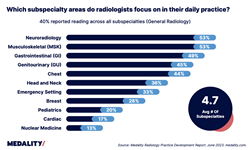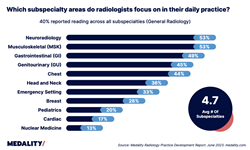
The 2023 Radiology Practice Development Report
“We need to ensure more radiologists are well-trained and confident in their skills in order to meet demand and provide quality care.” -Deanna M. Heier, PhD, VP of Educational Strategy and Operations at Medality.
CINCINNATI (PRWEB)
June 20, 2023
Medality, the leading practice development platform for radiologists and imaging organizations, today announced the release of its 2023 Radiology Practice Development Report. This comprehensive report highlights the most critical training gaps and opportunities in radiology and is based on insights from over 2,700 radiologists across 108 countries.
The report reveals that radiologists are reading across an average of 4.7 subspecialty areas in their daily practice, with 40% reporting they read across all radiology subspecialties. These results are striking given a global effort toward increased subspecialization, though perhaps not surprising given that Practice leaders & Chief Medical Officers report ongoing challenges keeping up with increasing volumes in a broadening range of subspecialties and technologies.
This highlights the rise of the “multispecialty radiologist”[1] and aligns with findings that the majority (55%) of radiologists practice in three or more subspecialties[2] and 85% practice in two or more subspecialties.[3]
The 2023 Radiology Practice Development Report also finds that confidence levels among current readers in each subspecialty varied widely. While most radiologists are at least somewhat confident, < 50% reported they are very confident reading cases in a subspecialty they currently read in daily practice.
Most striking was a lack of confidence in high-growth imaging areas like Cardiac, Nuclear Medicine and Pediatrics. Radiologists report being less confident when reading:
- Cardiac imaging (41% not confident)
- Nuclear medicine (28% not confident)
- Pediatric imaging (25% not confident)
- Musculoskeletal imaging (23% not confident)
- Breast imaging (22% not confident)
- Head & Neck imaging (21% not confident)
“The lack of confidence among Cardiac readers is a particularly concerning result given the recent shift in US clinical practice guidelines where CCTA was given multiple class 1, level A recommendations for chest pain,” said Deanna M. Heier, PhD, VP of Educational Strategy and Operations at Medality.
“Cardiac CT volumes are expected to increase in the coming years. We need to ensure more radiologists are well-trained and confident in their skills in order to meet demand and provide quality care,” Heier added. “One piece of good news in the report is that we found that radiologists want to be trained in cardiac imaging, which had the highest interest for upskilling among all radiology subspecialties surveyed.”
The report also highlights a high interest in MRI training and education. Among all the imaging modalities, radiologists were most interested in learning about MRI imaging consistently across all subspecialties (Neuroradiology-97%, MSK-95%, GU-91%, GI-88%, Breast-84%, Cardiac 81%).
MRI volume has steadily increased over the last three decades. Many highly experienced radiologists were never trained in reading MRI scans, and given the high RVU values of MRIs, many are looking to improve their proficiency in this area.
Top subspecialty areas that radiologists are most interested in learning about are MSK and Neuroimaging, with about half of radiologists seeking to improve their proficiency in these areas.
“The strong demand for MSK and Neuro education is not surprising given the economic realities of private practice,” said Daniel Arnold, CEO and Co-Founder of Medality. “In a private practice setting, MSK and Neuroradiology scans generate high reimbursement and together make up the majority of outpatient MRI center volume. Referring clinicians in an outpatient setting such as orthopedic surgeons and neurosurgeons, have their choice of where to refer patients and will send to those with higher quality images and reports,” Arnold added.
According to the report, the need for practice development is a real challenge for the field of radiology where imaging demands are increasing at a faster rate than the workforce can sustain.
While subspecialty fellowships are still popular, many residents are now entering the job market without fellowship training and are expected to quickly develop their skills on-the-job in multiple subspecialty areas.
Highly experienced radiologists are being asked to read in new areas and new technologies that were not part of their training. Upskilling and improved training is key to increasing the efficiency of the current workforce quickly and effectively.
Get access to the complete 2023 Radiology Practice Development Report at https://medality.com/2023-radiology-practice-developement-report/.
About Medality
Medality is the leading practice development platform for radiologists and medical imaging organizations. Medality helps tens of thousands of radiologists from over 100 countries upskill in high-growth, advanced imaging areas with case-based microlearning video courses and integrated cases designed to simulate clinical practice from anywhere, anytime. Imaging organizations use Medality to improve diagnostic and reporting quality, reduce turnaround times, and expand their breadth of practice quickly in the areas they need it most. Learn more at http://www.medality.com.
References:
[1] https://pubmed.ncbi.nlm.nih.gov/33676913/
[2] https://pubs.rsna.org/doi/10.1148/radiol.2017171684
[3] https://www.sciencedirect.com/science/article/abs/pii/S1076633220301057
Share article on social media or email:

